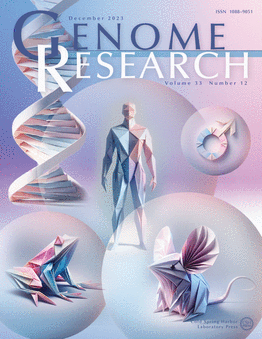The rate and spectrum of new mutations in mice inferred by long-read sequencing
IF 6.2
2区 生物学
Q1 BIOCHEMISTRY & MOLECULAR BIOLOGY
引用次数: 0
Abstract
All forms of genetic variation originate from new mutations, making it crucial to understand their rates and mechanisms. Here, we use long-read PacBio sequencing to investigate de novo mutations that accumulated in 12 inbred mouse lines derived from three commonly used inbred strains (C3H, C57BL/6, and FVB) maintained for 8-15 generations in a mutation accumulation (MA) experiment. We built chromosome-level genome assemblies based on the MA line founders' genomes, and then employed a combination of read and assembly-based methods to call the complete spectrum of new mutations. On average, there are ~45 mutations per haploid genome per generation, about half of which (54%) are insertions and deletions shorter than 50 bp (indels). The remainder are single nucleotide mutations (SNMs, 44%) and large structural mutations (SMs, 2%). We found that the degree of DNA repetitiveness is positively correlated with SNM and indel rates, and that a substantial fraction of SMs can be explained by homology-dependent mechanisms associated with repeat sequences. Most (90%) indels can be attributed to microsatellite contractions and expansions, and there is a marked bias towards 4 bp indels. Among the different types of SMs, tandem repeat mutations have the highest mutation rate, followed by insertions of transposable elements (TEs). We uncover a rich landscape of active TEs, and notable differences in their spectrum among MA lines and strains, and a high rate of gene retroposition. Our study offers novel insights into mammalian genome evolution, and highlights the importance of repetitive elements in shaping genomic diversity.通过长读测序推断小鼠新突变的速率和谱
所有形式的遗传变异都源于新的突变,因此了解它们的速率和机制至关重要。在这里,我们使用长读PacBio测序研究了在突变积累(MA)实验中积累在12个自交系(C3H, C57BL/6和FVB)中积累8-15代的新生突变。我们基于MA系创始人的基因组构建了染色体水平的基因组组装,然后结合基于读取和组装的方法来调用新突变的完整谱。平均每个单倍体基因组每代约有45个突变,其中约一半(54%)是短于50 bp (indel)的插入和缺失。其余为单核苷酸突变(SNMs, 44%)和大结构突变(SMs, 2%)。我们发现DNA的重复程度与SNM和indel率呈正相关,并且相当一部分的SMs可以通过与重复序列相关的同源依赖机制来解释。大多数(90%)指数可归因于微卫星收缩和扩张,并且明显偏向于4 bp指数。在不同类型的SMs中,串联重复突变的突变率最高,其次是转座因子插入。我们发现了丰富的活性te景观,在MA系和菌株之间的光谱差异显著,基因逆转录率高。我们的研究为哺乳动物基因组进化提供了新的见解,并强调了重复元素在塑造基因组多样性中的重要性。
本文章由计算机程序翻译,如有差异,请以英文原文为准。
求助全文
约1分钟内获得全文
求助全文
来源期刊

Genome research
生物-生化与分子生物学
CiteScore
12.40
自引率
1.40%
发文量
140
审稿时长
6 months
期刊介绍:
Launched in 1995, Genome Research is an international, continuously published, peer-reviewed journal that focuses on research that provides novel insights into the genome biology of all organisms, including advances in genomic medicine.
Among the topics considered by the journal are genome structure and function, comparative genomics, molecular evolution, genome-scale quantitative and population genetics, proteomics, epigenomics, and systems biology. The journal also features exciting gene discoveries and reports of cutting-edge computational biology and high-throughput methodologies.
New data in these areas are published as research papers, or methods and resource reports that provide novel information on technologies or tools that will be of interest to a broad readership. Complete data sets are presented electronically on the journal''s web site where appropriate. The journal also provides Reviews, Perspectives, and Insight/Outlook articles, which present commentary on the latest advances published both here and elsewhere, placing such progress in its broader biological context.
 求助内容:
求助内容: 应助结果提醒方式:
应助结果提醒方式:


